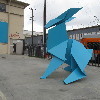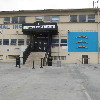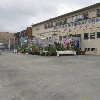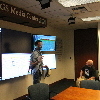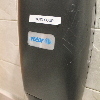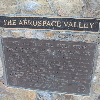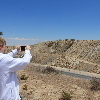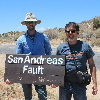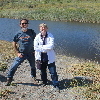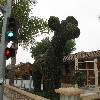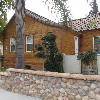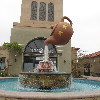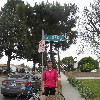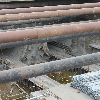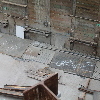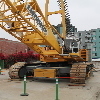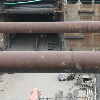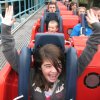This Saturday was the fourth time I’ve been part of leading the San Andreas Fault tour with Atlas Obscura. The last time I did this was in October of last year, and my partner that time was Morgan from the USGS office. But this time, she was offered a chance to go to a conference in Japan, so Nicholas was my partner for the tour. We also had a special guest along this time. Back in April, Kathleen and I had gone on the Nastie Nellie Oleson Tour with Alison Arngrim in Hollywood. This was tremendously entertaining, and along the way, I told Alison about the earthquake tour. She was interested, but the tour was already sold out. But it turned out that Sandi had held one seat in reserve in case Nicholas or I wanted to bring a guest, so Alison got the guest seat for the tour.
After a quick tour of the Seismo Lab, we headed up to the fault scarp at the McDonald’s in San Fernando. I also went inside to get some iced tea and to use the bathroom. That was where I saw what I can only assume is an unfortunate typo on the soap dispenser.
In Palmdale, we took in the view from the overlook by the freeway, and then climbed up the little hill so we could look down into the famous road cut where the 14 freeway crosses the fault. Then it was time for our lunch stop at Charlie Brown Farms. After that, it was time for Pallett Creek. We knew that the mysterious signs that marked where the fault crosses the road had been recently vandalized after more than a decade of marking the spot. So I’d made a new sign, which we brought along to use for the photo-op, even if it’s not properly planted in the ground. Then we traveled the quarter-mile or so to the actual trench site next to Pallett Creek. It’s not much to see, but it’s a chance to talk about how Kerry Sieh invented the science of paleoseismology there, back in the 1970s.
Heading up into the mountains, we stopped at the road cut near Big Pines to dig in the fault gouge. Then a quick bathroom stop in Wrightwood before heading down the other side of the mountain into Cajon Pass. There, we got to see Lost Lake, a small sag pond on the fault there. I like Lost Lake just because it looks like such an improbable thing. A pond all by itself, surrounded by desert. We also were very lucky this time. To get to the lake, we have to cross four railroad tracks. On the way in, we saw a train that had just finished passing the crossing when we got there. And while we were at Lost Lake, I saw another train come by. But that one finished passing by just as we were leaving. Cajon Pass is one of the toughest stretches of railroad in the U.S., and the trains there tend to be very long, and very slow-moving, so we were lucky to have missed both of them this time.
